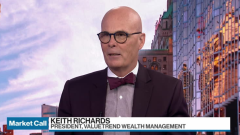Oct 27, 2023
Bank Stocks Sink Past SVB Crisis Lows as Rates Upend Business
, Bloomberg News

(Bloomberg) -- An index of the largest US bank stocks fell below the level hit just after the collapse of First Republic Bank in May as the sector grapples with higher interest rates that have dimmed earnings prospects.
The KBW Bank Index fell 2.3% Friday to close at a level not seen since September 2020. The group of 24 lenders has tumbled 29% this year, with much of the rout coming after Silicon Valley Bank’s collapse in March and First Republic’s demise two months later. The latest batch of earnings from heavyweights like Morgan Stanley and Citigroup Inc. added to the woes. The S&P 500 is up 7.2% in 2023.
Investors have bolted from lenders as a panoply of pressures weighs on the group’s earnings prospects. A surge in yields on long-dated Treasuries has rekindled worries about the value of securities portfolios, the very issue that sank the regionals in the spring. The Federal Reserve’s pledge to pin interest rates at two-decade highs is clouding profit forecasts for next year, and regulators, wary of another broader financial-sector crisis in the case of an economic slowdown, have proposed raising capital requirements.
“The problem is there’s still a very wide sense of skepticism about the group’s prospects,” Piper Sandler analyst R. Scott Siefers said. “It really feels like gone are the days of those panicky events of the spring. But investors have really just settled in for a long slog for the group.”
The latest leg down for banks comes at a perilous time for the broader market, where the tech stalwarts that carried indexes to massive first-half gains have also started to wobble. Alphabet Inc. just suffered its worst day since 2020, while Tesla Inc. lost about 9% after lukewarm earnings on Oct. 19. The S&P 500 shed more than 10% since its July high, while the Nasdaq 100 is off almost 11% from its summer peak.
Bank shares first came under fire earlier this year following the collapses of Silicon Valley Bank and Signature Bank in March. The bank gauge plunged 25% that month. Then the losses deepened in May, when First Republic Bank became the second largest bank failure in US history. Investors pivoted in summer to the bigger money-center banks for safety and saw concerted gains in June and July.
Some of the stabilization owed to the removal of existential fears, given support from the Fed. But the mood soured in recent weeks as a relentless run-up in interest rates forced investors to reconsider the earnings outlook for the group.
“We were in the acute phase of a disease back in the spring, and now we’re in the chronic phase,” Siefers said.
With shares of the biggest banks now faltering, the cap-weighted KBW Bank Index is plumbing fresh lows. JPMorgan Chase & Co. lost 3.6% Friday for its worst day since March 17 after Chief Executive Officer Jamie Dimon disclosed plans to sell 1 million shares of the bank. Goldman Sachs Group, Inc.’s market cap tipped below $100 billion. And Morgan Stanley shares are churning near the lowest level since early 2021, a week after the firm plunged on disappointing earnings. Bank of America Corp. is at the lowest level since 2020 amid its wrong-way bet on rates.
Among the stocks in the KBW Bank Index that have tumbled the most this year: First Horizon Corp. is down 57%, KeyCorp has dropped 43% and and Comerica Inc. is lower by 43%. Of the largest US banks by market cap: Bank of America Corp. fell 24%, Citigroup Inc. slid 15% and Morgan Stanley was lower by 17%.
“Valuations may seem attractive but there is uncertainty about the economic outlook and implications of higher for longer rates,” JPMorgan analyst Vivek Juneja wrote. “The sector is lacking a catalyst near term as commercial loans are weak, and capital markets issuance activity has also slowed down following a pick-up in September - both these drivers are being hurt by the above mentioned uncertainty.”
©2023 Bloomberg L.P.






